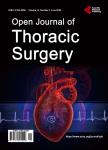Interplay between Platelet Endothelial Cell Adhesion Molecule-1 and Pigment Epithelium-Derived Factor in Non-Small-Cell-Lung Cancer
Interplay between Platelet Endothelial Cell Adhesion Molecule-1 and Pigment Epithelium-Derived Factor in Non-Small-Cell-Lung Cancer作者机构:Department of Thoracic and Cardiovascular Surgery University Medical Center Gö ttingen Gö ttingen Germany Institute of Pathology University Medical Center Gö ttingen Gö ttingen Germany
出 版 物:《Open Journal of Thoracic Surgery》 (胸外科期刊(英文))
年 卷 期:2016年第6卷第4期
页 面:47-56页
学科分类:1002[医学-临床医学] 100214[医学-肿瘤学] 10[医学]
主 题:NSCLC PEDF PECAM-1 Neoangiogenesis
摘 要:Pigment epithelium-derived factor (PEDF), a potent antiangiogenesis agent, is a multifunctional protein with important roles in regulation of inflammation and angiogenesis. It has recently attracted attention for targeting tumor cells in several types of tumors. PECAM-1 is an integral membrane protein, a cell adhesion molecule with proangiogenic activity and plays an important role in the process of angiogenesis. The correlation between proangiogenic activity PECAM-1 and antiangiogenic activity PEDF in Non-Small-Cell-Lung Cancer has not been reported. The present study was designed to evaluate using immunohistochemical techniques and multivariate analysis the interplay between PECAM-1 and PEDF in NSCLC, especially in adenocarcinoma and in squamous cell carcinoma stage IA-IIIB. Analyzing the mixed study collectively (n = 69), there was no significant correlation (p = 0.553) between PECAM-1 signal and PEDF area. Only including patients with adenocarcinoma (Figure 2), we found a positive correlation between PECAM-1 signal and PEDF area (p = 0.025). In patients with squamous cell carcinoma, we did not find a significant correlation between PECAM-1 signal and PEDF area (p = 0.530). In patients with squamous cell carcinoma, PECAM-1 and PEDF show a significant different expression pattern, measured via staining intensity (p = 0.013). These results might support the hypothesis that squamous cell carcinomas heavily rely on angiogenic processes.



